Visible planets and night sky January 2023
Posted by
Marcy Curran and John Jardine Goss and Deborah Byrd
December 31, 2022

The waxing gibbous moon sits high in the sky next to the glittering Pleiades star cluster on January 2, 2023. Then – for all of us around the globe – the moon is near Mars the following night of January 3. Southern Hemisphere? Look north and turn this chart upside down. The waxing gibbous moon is up at sunset and sets a few hours before dawn. The bright red star near Mars is Aldebaran, the Eye of Taurus the Bull. Mars reached its once-in-2-years opposition on December 8, 2022. That was when Earth in its smaller, faster orbit passed between the sun and Mars, bringing Mars closest to us for this 2-year period. Mars was also brightest then in our sky. Now Earth is flying ahead of Mars in orbit, and Mars’ brightness is beginning to dim. Read more about the moon near Mars and Pleiades. Chart via John Jardine Goss/ EarthSky.
Available now! 2023 EarthSky lunar calendar. A unique and beautiful poster-sized calendar showing phases of the moon every night of the year. Makes a great gift!
Mars is high in the evening sky and is visible until a few hours before dawn. It’s very red now and brighter than most stars. Mars reached opposition on December 8, 2022, when Earth flew between Mars and the sun.
Saturn is low in the southwestern sky after sunset. It’s golden in color and shines steadily, and the best time for observing is right after darkness falls. It sets by around 8 p.m. local time at the beginning of January and around 6 p.m. at the end of the month.
Venus, the brightest planet and next planet inward from Earth in orbit around the sun, is climbing higher each night out of the sunset twilight. By the end of January, it sets about two hours after sunset.
Mercury will reappear in the morning sky around mid-month. Mercury reaches greatest elongation on January 30, 2023.
People often ask if our charts apply to them. Yes, if you’re in the Northern Hemisphere. Not as precisely, however, if you’re in the Southern Hemisphere. Our charts are mostly set for the northern half of Earth. To see a precise view from your location, try the free online planetarium, Stellarium.
Looking for a dark sky? Try EarthSky’s Best Places to Stargaze
In this article:

Brilliant Venus and golden Saturn pair up in the January 2023 evening sky. Shortly after sunset, bright Venus climbs higher in the west-southwest each evening, while the dimmer Saturn sinks lower. They are near each other on January 20-24, and are closest on the evening of January 22, 2023, when they are 0.4 degrees apart. Venus will reach its greatest elongation from the sun on June 4, 2023, and be visible in the evening sky through August. Saturn is best viewed in early January and poorly placed by month’s end. Saturn will be in conjunction with the sun on February 16, 2023, then emerging as a morning object in March. Chart via John Jardine Goss/ EarthSky.
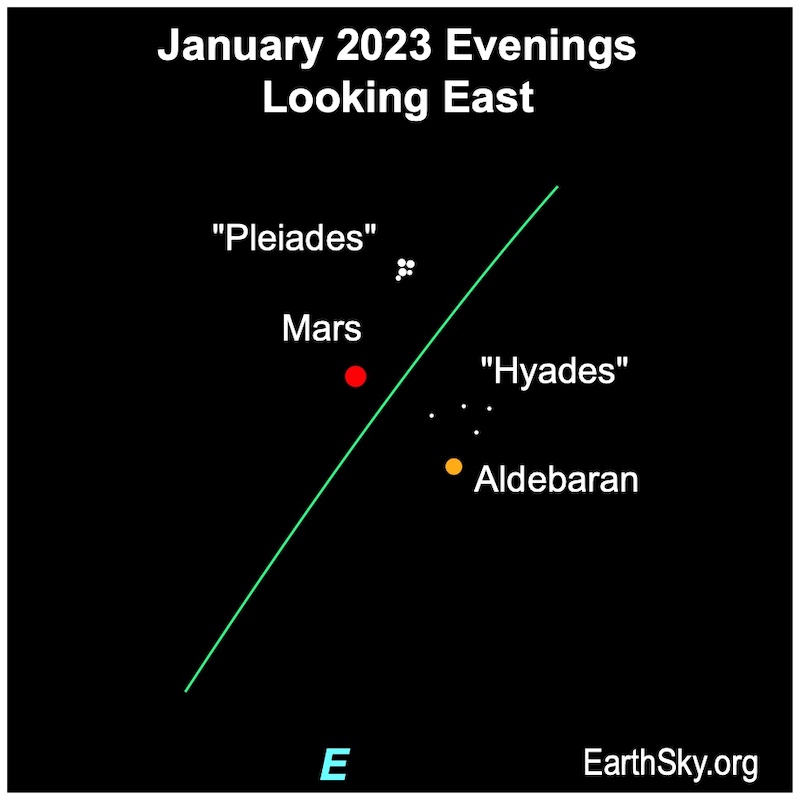
In the evenings throughout January 2023, bright red Mars is in the constellation of Taurus the Bull. It’s near the shimmering Pleiades star cluster. Also nearby, the bright red star Aldebaran can guide you to a V-shaped star cluster known as the Hyades. Mars is well placed for observing most of the night. By the way, on December 8, 2022, Mars reached its once-in-2-years opposition. So in January, Mars is the brightest it will be this year but will start the month at magnitude -1.2 dimming to magnitude -0.3 at month’s end. Chart via John Jardine Goss/ EarthSky.
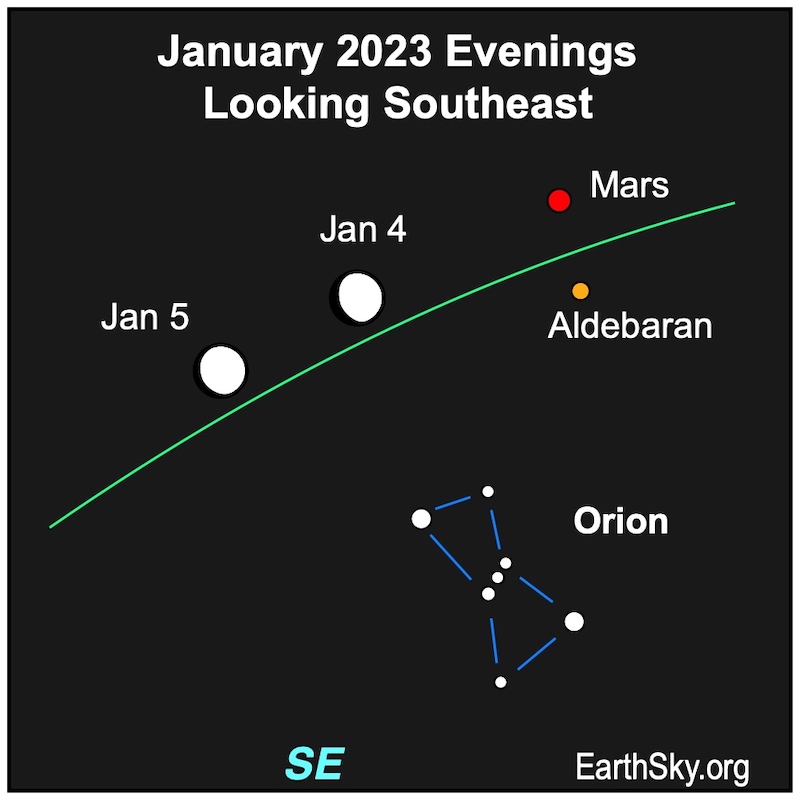
On the nights of January 4 and 5, 2023, the bright waxing gibbous moon moves above Orion the Hunter and slides eastward away from Mars. Below Mars is the fiery red star Aldebaran, the Eye of Taurus the Bull. While Mars currently rivals our brightest stars, it’s at its brightest for this year. Mars was recently closest to Earth on November 30, 2022, and reached opposition on December 8, 2022. Read more about the moon near Orion. Chart via John Jardine Goss/ EarthSky.
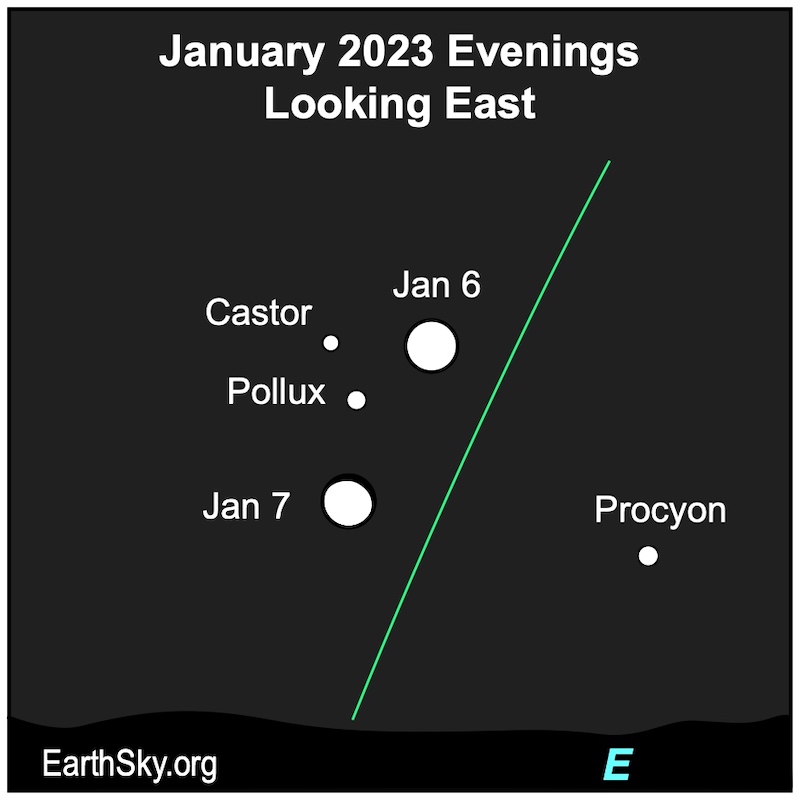
The full moon shines brightly by Gemini‘s twin stars, Castor and Pollux, all night on January 6, 2023, with the waning gibbous moon passing them on January 7. In the Southern Hemisphere, the waning gibbous moon pairs closest with Castor and Pollux on January 7. Although the twin stars don’t look alike, they are quite noticeable near each other in the sky, because they’re bright and close together. Castor is the slightly dimmer star of the pair. And Pollux is more golden in color. Also nearby is Procyon, the brightest star in Canis Minor the Lesser Dog. It’s sometimes called the Little Dog Star. Read more about the moon near Castor and Pollux. Chart via John Jardine Goss/ EarthSky.
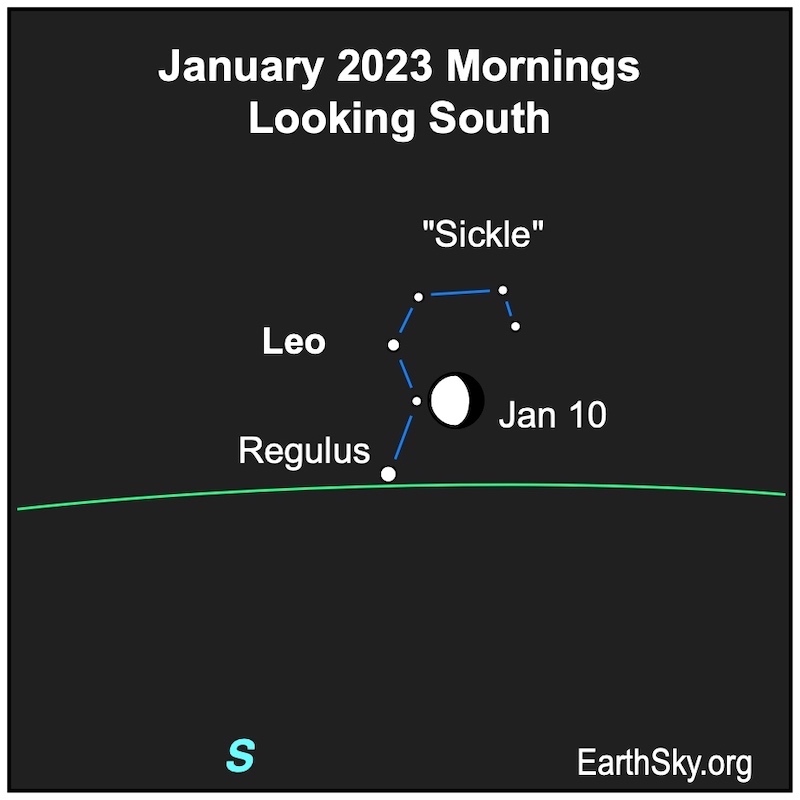
The morning of January 10, 2023, finds the waning gibbous moon glowing in the Sickle of Leo the Lion. If you aren’t an early riser, you can see the moon near Leo starting mid-evening – the night before – on January 9. You’ll notice the bright star Regulus as well. Regulus is the only 1st-magnitude star that sits almost right on the ecliptic, the path the sun follows through the sky. So Regulus is often near a bright planet and can even be occulted by the moon. Read more about the moon near the Sickle of Leo. Chart via John Jardine Goss/ EarthSky.

The morning of January 14, 2023, finds the waning gibbous moon near the star Spica in Virgo the Maiden. Then on January 15, the waning crescent moon glows in the southeast next to the star Spica. In fact, after midnight – on both days – you can see the moon near Spica. The last quarter moon occurs at 2:10 UTC on January 15 (or 8:10 p.m. CST on January 14). Read more about the moon near Spica. Chart via John Jardine Goss/ EarthSky.
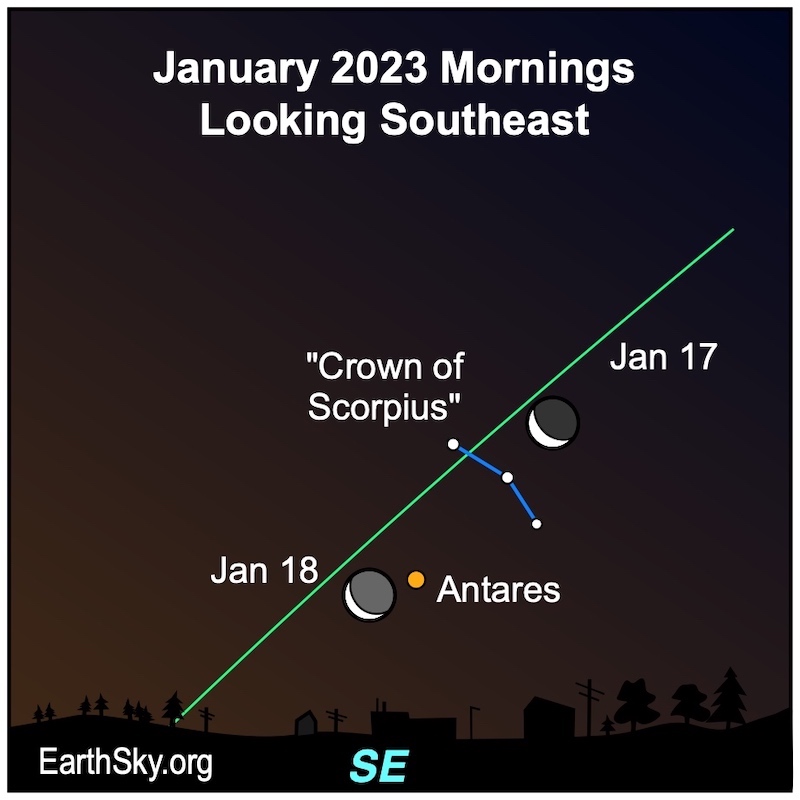
On the morning of January 17, 2023, the waning crescent moon floats above the Crown of Scorpius in the brightening morning twilight. On the following morning, January 18, an even thinner crescent moon lies immediately left of the fiery red star Antares, the brightest star in Scorpius the Scorpion. In the Southern Hemisphere, the moon is closest to the Crown of Scorpius on January 18. Also, the beautiful glow you see on the unlit portion of the moon is earthshine. Read more about the moon near Scorpius. Chart via John Jardine Goss/ EarthSky.
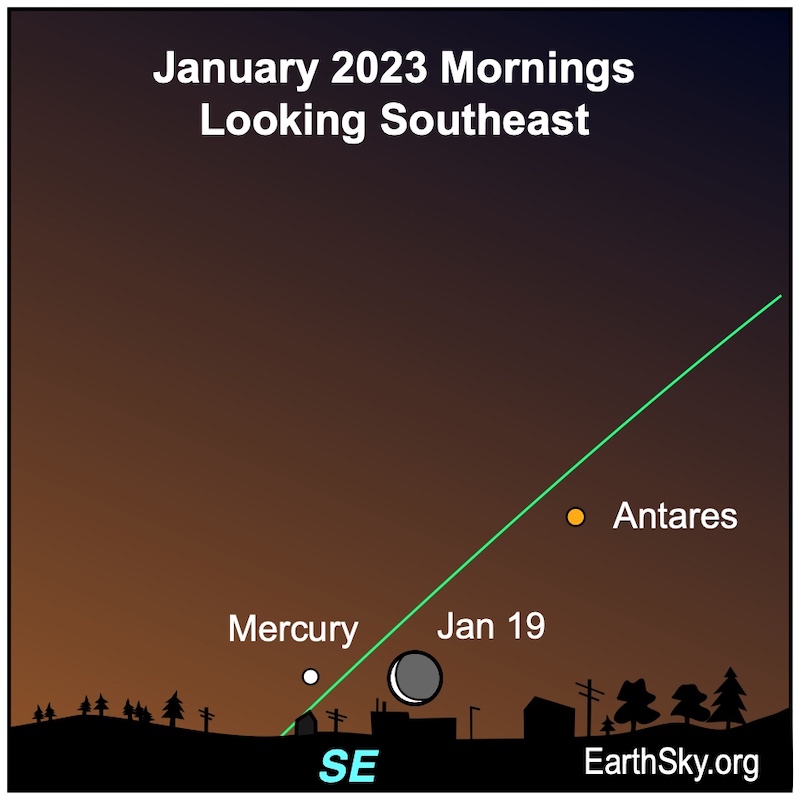
The very thin waning crescent moon hangs in the southeastern sky before sunrise on January 19, 2023. It sits to the right of Mercury in the morning twilight (above Mercury for those in the Southern Hemisphere.) Mercury will reach greatest elongation on January 30, 2023. Look for the lovely glow of earthshine on the unlit portion of the moon. Higher in the sky is the bright red star Antares in the constellation of Scorpius the Scorpion. Read more about the moon near Mercury. Chart via John Jardine Goss/ EarthSky.
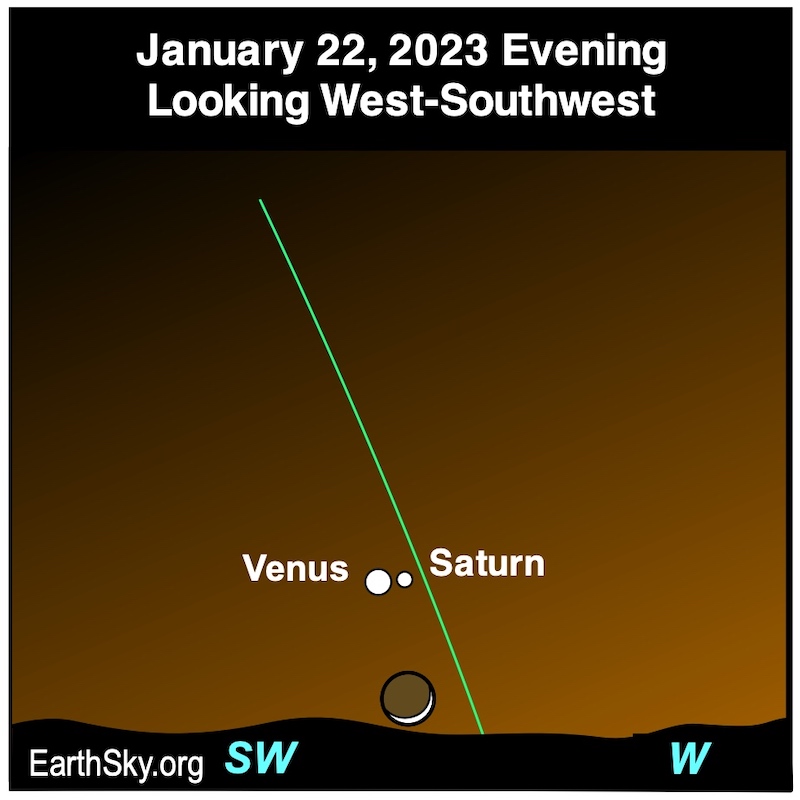
Bright Venus and beautiful Saturn have a close conjunction on January 22, 2023. The planetary pair are only 0.4 degrees apart that evening. Venus will continue climbing higher in the sky each night, and Saturn will soon slip away from view into the sunset. A very young waxing crescent moon – a little over a day old – hangs below the pair near the horizon. The lovely glow on the darkened portion of the moon is earthshine. Chart via John Jardine Goss/ EarthSky.
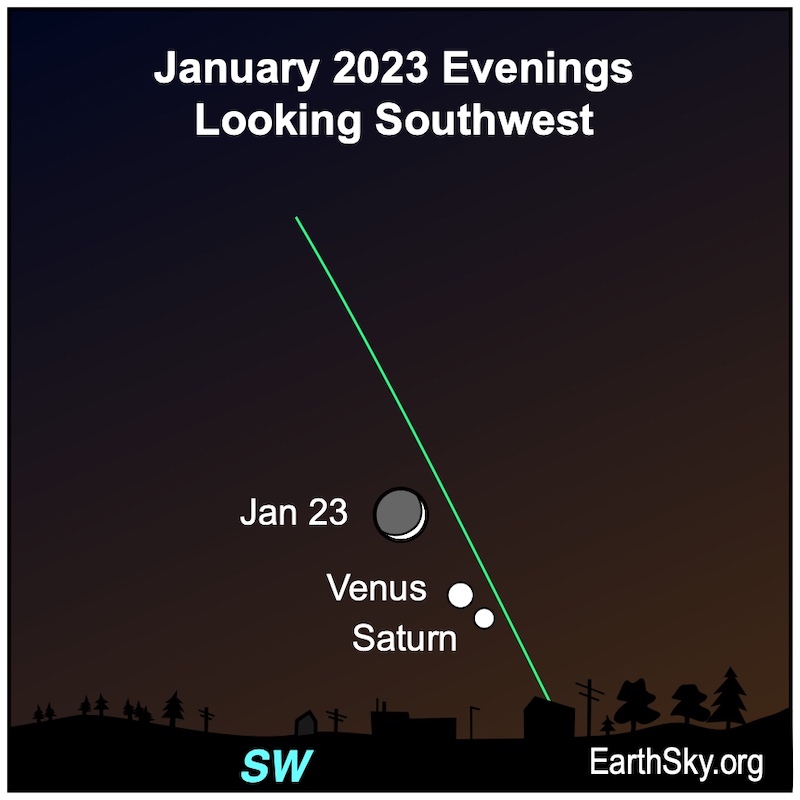
The thin waxing crescent moon shines low in the sky with Venus and Saturn after sunset on January 23, 2023. Venus emerged into the evening sky last month and will reach its greatest elongation from the sun on June 4, 2023. By the way, the beautiful glow you see on the unlit portion of the moon is earthshine. Saturn is poorly placed for viewing now and will be in conjunction with the sun on February 16, 2023. When is the last day you will see Saturn in the evening twilight? Chart via John Jardine Goss/ EarthSky.
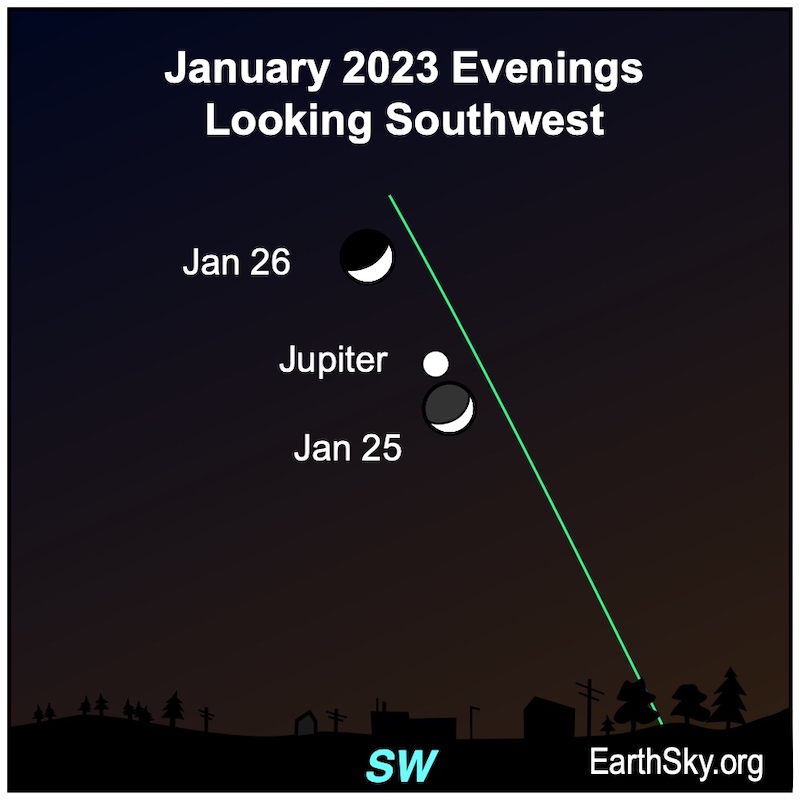
The waxing crescent moon shines below Jupiter after sunset on January 25, 2023, and above the planet on January 26. Jupiter, the largest planet in our solar system, has been dominant in the evening sky for months and sets around 10 p.m. local time at the end of December. Chart via John Jardine Goss/ EarthSky.
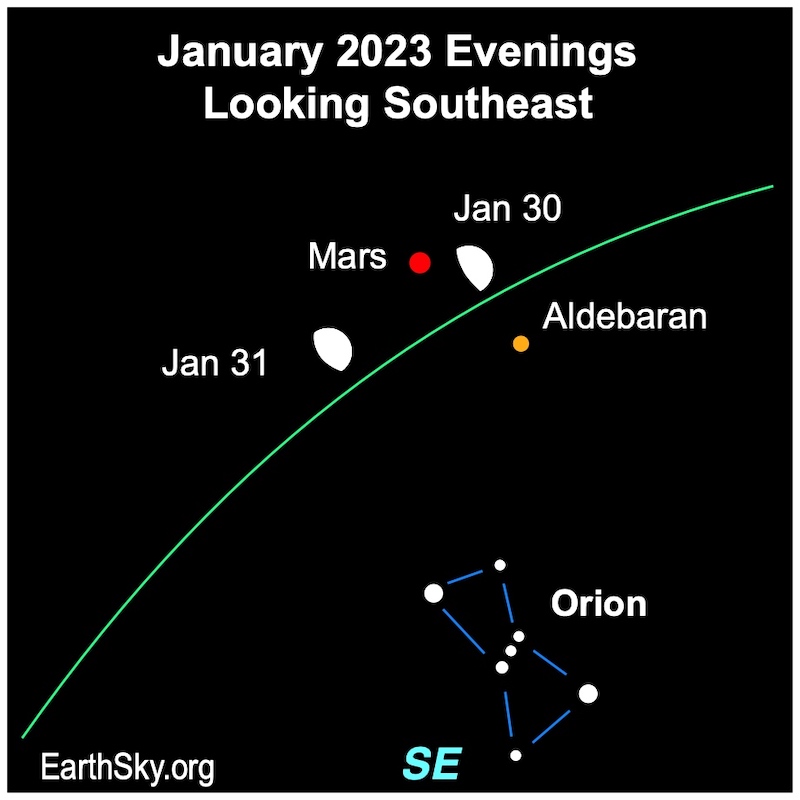
The waxing gibbous moon slides by Mars on the nights of January 30 and 31, 2023, then sets a few hours before sunrise. Another red object near Mars is the fiery red star Aldebaran, the Eye of Taurus the Bull. The eye-catching constellation of Orion the Hunter finishes out the cosmic scene. Chart via John Jardine Goss/ EarthSky.
Thanks to: https://earthsky.org/astronomy-essentials/visible-planets-tonight-mars-jupiter-venus-saturn-mercury/?utm_source=EarthSky+News&utm_campaign=58c2dc9283-EMAIL_CAMPAIGN_2018_02_02_COPY_01&utm_medium=email&utm_term=0_c643945d79-58c2dc9283-393775709&mc_cid=58c2dc9283&mc_eid=87f7e1dbd6
Posted by
Marcy Curran and John Jardine Goss and Deborah Byrd
December 31, 2022

The waxing gibbous moon sits high in the sky next to the glittering Pleiades star cluster on January 2, 2023. Then – for all of us around the globe – the moon is near Mars the following night of January 3. Southern Hemisphere? Look north and turn this chart upside down. The waxing gibbous moon is up at sunset and sets a few hours before dawn. The bright red star near Mars is Aldebaran, the Eye of Taurus the Bull. Mars reached its once-in-2-years opposition on December 8, 2022. That was when Earth in its smaller, faster orbit passed between the sun and Mars, bringing Mars closest to us for this 2-year period. Mars was also brightest then in our sky. Now Earth is flying ahead of Mars in orbit, and Mars’ brightness is beginning to dim. Read more about the moon near Mars and Pleiades. Chart via John Jardine Goss/ EarthSky.
Available now! 2023 EarthSky lunar calendar. A unique and beautiful poster-sized calendar showing phases of the moon every night of the year. Makes a great gift!
Visible planets (evening)
Jupiter is easy to spot, brighter than all the stars. It’s in the southwest sky after sunset. It sets after 11 p.m. local time in early January and is gone after 9:30 p.m. at month’s end.Mars is high in the evening sky and is visible until a few hours before dawn. It’s very red now and brighter than most stars. Mars reached opposition on December 8, 2022, when Earth flew between Mars and the sun.
Saturn is low in the southwestern sky after sunset. It’s golden in color and shines steadily, and the best time for observing is right after darkness falls. It sets by around 8 p.m. local time at the beginning of January and around 6 p.m. at the end of the month.
Venus, the brightest planet and next planet inward from Earth in orbit around the sun, is climbing higher each night out of the sunset twilight. By the end of January, it sets about two hours after sunset.
Visible planets (morning)
On January mornings, Mars is shining brightly in the west (opposite the sunrise horizon) a few hours before sunrise. Since Mars reached opposition on December 8, 2022, Mars is now the brightest it will be in 2023.Mercury will reappear in the morning sky around mid-month. Mercury reaches greatest elongation on January 30, 2023.
People often ask if our charts apply to them. Yes, if you’re in the Northern Hemisphere. Not as precisely, however, if you’re in the Southern Hemisphere. Our charts are mostly set for the northern half of Earth. To see a precise view from your location, try the free online planetarium, Stellarium.
Looking for a dark sky? Try EarthSky’s Best Places to Stargaze
In this article:
- Night sky guide January 2023
- Some resources to enjoy
Visible planets and night sky guide January 2023
January evenings: Venus and Saturn near each other

Brilliant Venus and golden Saturn pair up in the January 2023 evening sky. Shortly after sunset, bright Venus climbs higher in the west-southwest each evening, while the dimmer Saturn sinks lower. They are near each other on January 20-24, and are closest on the evening of January 22, 2023, when they are 0.4 degrees apart. Venus will reach its greatest elongation from the sun on June 4, 2023, and be visible in the evening sky through August. Saturn is best viewed in early January and poorly placed by month’s end. Saturn will be in conjunction with the sun on February 16, 2023, then emerging as a morning object in March. Chart via John Jardine Goss/ EarthSky.
Jupiter evenings: Jupiter in Pisces
Jupiter, the largest planet in our solar system, shines brightly in the January 2023 evening sky. It’s the brightest “star” high in our southwestern night sky; you can’t miss it. In fact, it’s probably the first point of light you’ll see as the sky starts to darken after sunset. Jupiter lies south of the eastern side of the Great Square, a group of 4 stars in the constellation Pegasus the Winged Horse. And between the Great Square and the bright planet is a pretty but faint group of 6 stars known as the Circlet. They compose the western section of the constellation Pisces the Fishes. You’ll need a dark sky to see the faint stars of Pisces. Chart via John Jardine Goss/ EarthSky.January evenings: Mars in Taurus

In the evenings throughout January 2023, bright red Mars is in the constellation of Taurus the Bull. It’s near the shimmering Pleiades star cluster. Also nearby, the bright red star Aldebaran can guide you to a V-shaped star cluster known as the Hyades. Mars is well placed for observing most of the night. By the way, on December 8, 2022, Mars reached its once-in-2-years opposition. So in January, Mars is the brightest it will be this year but will start the month at magnitude -1.2 dimming to magnitude -0.3 at month’s end. Chart via John Jardine Goss/ EarthSky.
January 3-4: Quadrantid meteor shower
January 4 and 5 evenings: Moon near Mars and Orion

On the nights of January 4 and 5, 2023, the bright waxing gibbous moon moves above Orion the Hunter and slides eastward away from Mars. Below Mars is the fiery red star Aldebaran, the Eye of Taurus the Bull. While Mars currently rivals our brightest stars, it’s at its brightest for this year. Mars was recently closest to Earth on November 30, 2022, and reached opposition on December 8, 2022. Read more about the moon near Orion. Chart via John Jardine Goss/ EarthSky.
The instant of full moon is 23:08 UTC on January 6 (5:08 p.m. CST)
January 6 and 7 evenings: Moon near Castor and Pollux

The full moon shines brightly by Gemini‘s twin stars, Castor and Pollux, all night on January 6, 2023, with the waning gibbous moon passing them on January 7. In the Southern Hemisphere, the waning gibbous moon pairs closest with Castor and Pollux on January 7. Although the twin stars don’t look alike, they are quite noticeable near each other in the sky, because they’re bright and close together. Castor is the slightly dimmer star of the pair. And Pollux is more golden in color. Also nearby is Procyon, the brightest star in Canis Minor the Lesser Dog. It’s sometimes called the Little Dog Star. Read more about the moon near Castor and Pollux. Chart via John Jardine Goss/ EarthSky.
January 10 morning: Moon near the Sickle of Leo

The morning of January 10, 2023, finds the waning gibbous moon glowing in the Sickle of Leo the Lion. If you aren’t an early riser, you can see the moon near Leo starting mid-evening – the night before – on January 9. You’ll notice the bright star Regulus as well. Regulus is the only 1st-magnitude star that sits almost right on the ecliptic, the path the sun follows through the sky. So Regulus is often near a bright planet and can even be occulted by the moon. Read more about the moon near the Sickle of Leo. Chart via John Jardine Goss/ EarthSky.
January 14 and 15 mornings: Moon near Spica

The morning of January 14, 2023, finds the waning gibbous moon near the star Spica in Virgo the Maiden. Then on January 15, the waning crescent moon glows in the southeast next to the star Spica. In fact, after midnight – on both days – you can see the moon near Spica. The last quarter moon occurs at 2:10 UTC on January 15 (or 8:10 p.m. CST on January 14). Read more about the moon near Spica. Chart via John Jardine Goss/ EarthSky.
The instant of last quarter moon is 2:10 UTC on January 15 (8:10 p.m. CST January 14)
January 17 and 18 mornings: Moon near Scorpius

On the morning of January 17, 2023, the waning crescent moon floats above the Crown of Scorpius in the brightening morning twilight. On the following morning, January 18, an even thinner crescent moon lies immediately left of the fiery red star Antares, the brightest star in Scorpius the Scorpion. In the Southern Hemisphere, the moon is closest to the Crown of Scorpius on January 18. Also, the beautiful glow you see on the unlit portion of the moon is earthshine. Read more about the moon near Scorpius. Chart via John Jardine Goss/ EarthSky.
January 19 morning: Moon near Mercury

The very thin waning crescent moon hangs in the southeastern sky before sunrise on January 19, 2023. It sits to the right of Mercury in the morning twilight (above Mercury for those in the Southern Hemisphere.) Mercury will reach greatest elongation on January 30, 2023. Look for the lovely glow of earthshine on the unlit portion of the moon. Higher in the sky is the bright red star Antares in the constellation of Scorpius the Scorpion. Read more about the moon near Mercury. Chart via John Jardine Goss/ EarthSky.
The instant of new moon is 20:53 UTC (2:53 p.m. CST) on January 21
January 22 evening: Venus and Saturn conjunction

Bright Venus and beautiful Saturn have a close conjunction on January 22, 2023. The planetary pair are only 0.4 degrees apart that evening. Venus will continue climbing higher in the sky each night, and Saturn will soon slip away from view into the sunset. A very young waxing crescent moon – a little over a day old – hangs below the pair near the horizon. The lovely glow on the darkened portion of the moon is earthshine. Chart via John Jardine Goss/ EarthSky.
January 23 evening: Moon near Venus and Saturn

The thin waxing crescent moon shines low in the sky with Venus and Saturn after sunset on January 23, 2023. Venus emerged into the evening sky last month and will reach its greatest elongation from the sun on June 4, 2023. By the way, the beautiful glow you see on the unlit portion of the moon is earthshine. Saturn is poorly placed for viewing now and will be in conjunction with the sun on February 16, 2023. When is the last day you will see Saturn in the evening twilight? Chart via John Jardine Goss/ EarthSky.
January 25 and 26 evenings: Moon near Jupiter

The waxing crescent moon shines below Jupiter after sunset on January 25, 2023, and above the planet on January 26. Jupiter, the largest planet in our solar system, has been dominant in the evening sky for months and sets around 10 p.m. local time at the end of December. Chart via John Jardine Goss/ EarthSky.
The instant of 1st quarter moon is 15:19 UTC on January 28 (9:19 a.m. CST)
Mercury reaches greatest morning elongation on January 30 at 6 UTC (12 a.m. CST)
January 30 and 31 evenings: Moon near Mars

The waxing gibbous moon slides by Mars on the nights of January 30 and 31, 2023, then sets a few hours before sunrise. Another red object near Mars is the fiery red star Aldebaran, the Eye of Taurus the Bull. The eye-catching constellation of Orion the Hunter finishes out the cosmic scene. Chart via John Jardine Goss/ EarthSky.
Thanks to: https://earthsky.org/astronomy-essentials/visible-planets-tonight-mars-jupiter-venus-saturn-mercury/?utm_source=EarthSky+News&utm_campaign=58c2dc9283-EMAIL_CAMPAIGN_2018_02_02_COPY_01&utm_medium=email&utm_term=0_c643945d79-58c2dc9283-393775709&mc_cid=58c2dc9283&mc_eid=87f7e1dbd6






 Sat Mar 23, 2024 11:33 pm by globalturbo
Sat Mar 23, 2024 11:33 pm by globalturbo

